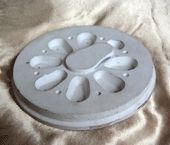 |
|

There are a number of occasions when an unusually shaped part is required for a model that may be either difficult to fabricate, or wasteful or difficult to machine from solid.
This often applies to larger objects (in model engineering terms), and for these, a casting is often the solution.

Examples of such would be spoked wheels, cylinder blocks and steam domes, and as evidenced by the number of suppliers offering castings for many designs of locomotives, traction engines and other items, they are obviously popular.

Here are a couple of pictures of a wheel made from cast iron, first as supplied; and then as finished after being turned on a lathe, and drilled.
But if the particular casting you require is not commercially available, you could choose to make a 'pattern', then find someone to 'cast' it in metal for you.
This item will discuss patterns required for Sand Casting, which covers the larger type of castings used in model engineering.
(For smaller, finely detailed parts "lost wax" casting is often used; this uses softer, lower melting point metals and alloys.)
Back to top
2. Designing a pattern - general principles.
Pattern making for model engineering is quite straight forward for many parts we use.
Essentially, the idea is to produce objects in the shape of the parts we want to produce, but excluding small holes or details which can be machined in later.
Where a number of parts are designed to fit closely together, they need to be designed a little oversize to allow for machining to exact size later.

However, unlike the finished part, which will be produced in solid metal, the pattern will not be subjected to heat, nor does it need to be terribly strong; so can be made from virtually anything.
This allows a number of ways of creating your shape, which can be cut from solid, fabricated, or cast; using wood, metal, fibreglass, car filler etc.
Although not intended to be exhaustive, here are some pointers to good pattern design:
Avoid sharp corners, angles and fillets
Avoid sharp section changes (blend smoothly)
Avoid large flat areas (use ribs and serrations)
Allow for shrinkage (see next section)
Design parting line in appropriate location
Design in draft angles (to release casting from mould)
Do not ask process to deliver unreasonably high tolerances
Allow extra material for surface finishing
Consider stress relieving
Enlist the help of a casting company to do the casting.
Patterns should be made with the person who has to cast them in mind.
The finished surface should be smooth and shiny, so that sand will not stick to it.
Back to top
3. Allow for shrinkage - required oversize dimensions.
Due to the fact that molten metals contract when they cool, and by different amounts, the pattern needs to be designed oversize according to the material in which the item is to be cast.
Also, sand casting does not produce a perfect surface finish, and can be quite grainy.
So depending on what is being cast, an additional allowance for machining may be required, in order that the 'skin' of the metal is cut away to give a uniform smooth finish.
This is obviously critical for things like wheel treads and cylinder bores, but not for wheel spokes which would just be cleaned up with a file.
Below is a table showing the dimensional increase required to make a pattern correctly oversize.
Where critical, check with the foundry, if known, as shrinkage rates can vary considerably with castings methods, and pouring temperatures.
 |
Table of Metals, showing Pattern oversize required,
Finishing Allowance, and minimum Wall Thickness
| Metal | Pattern Oversize Factor
(each direction) | Finish Allowance
(smaller number for larger sizes) | Minimum
Wall mm
(inches) |
| Aluminum | 1.08 - 1.12 | 0.5 to 1.0 % | 4.75
(0.187) |
| Copper alloys | 1.05 - 1.06 | 0.5 to 1.0 % | 2.3
(0.094) |
| Gray Cast Iron | 1.10 | 0.4 to 1.6 % | 3.0
(0.125) |
| Nickel alloys | 1.05 | 0.5 to 1.0 % | N/A |
| Steel | 1.05 - 1.10 | 0.5 to 2.0 % | 5.0
(0.20) |
| Magnesium alloys | 1.07 - 1.10 | 0.5 to 1.0 % | 4.0
(0.157) |
| Malleable Irons | 1.06 - 1.19 | 0.6 to 1.6 % | 3.0
(0.125) |
|
Back to top
4. Getting It Cast.
Having made or obtained a pattern, the next job is to get it cast.
However, unless you are determined, it really isn't worth the considerable effort to do it yourself.
By far the most cost effective way is to have it cast by a foundry.
Certain suppliers of locomotive castings also accept customer's own patterns for casting.
Back to top